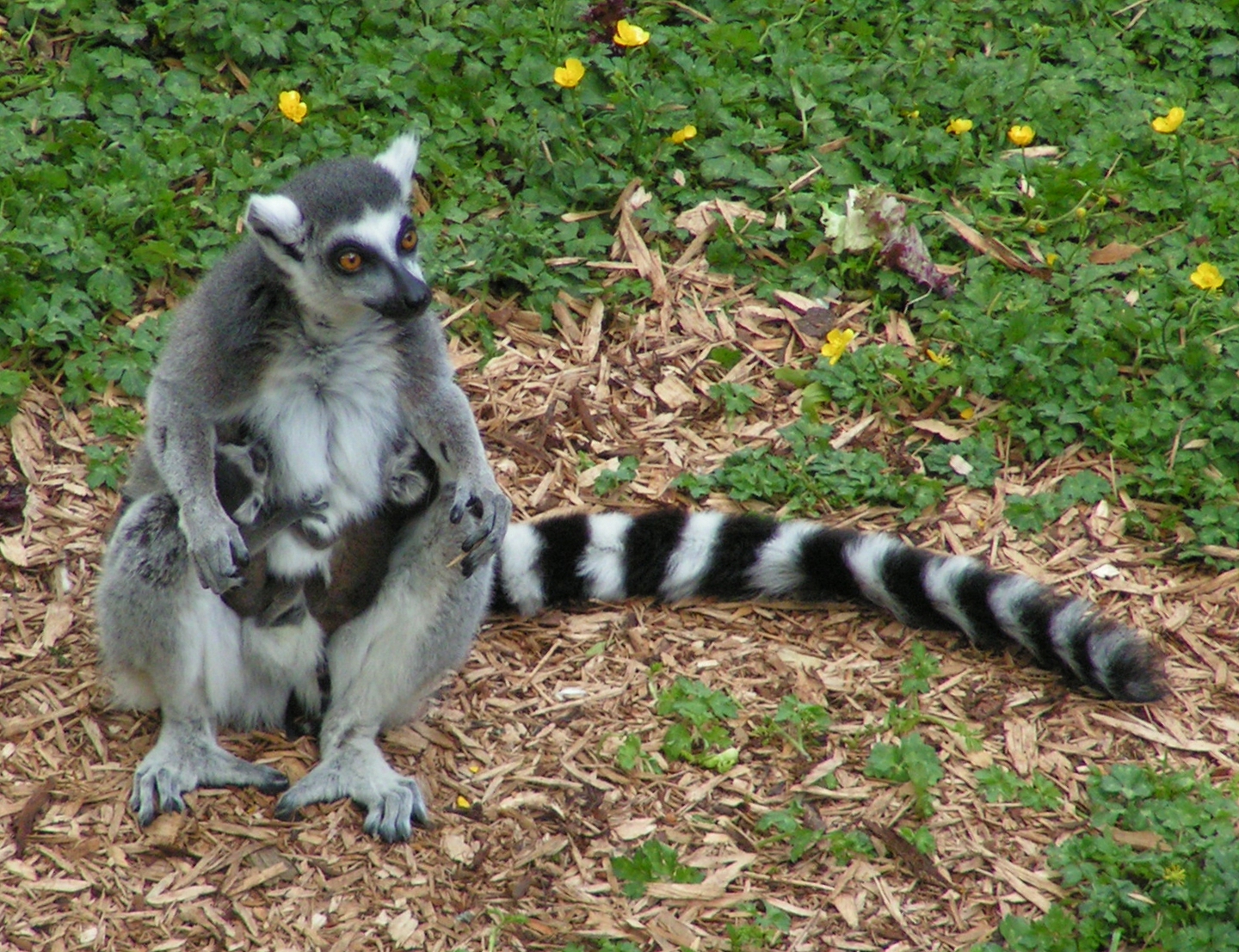Ring-tailed Lemur (Lemur catta) - Wiki Ring-tailed Lemur
From Wikipedia, the free encyclopedia
[Photo] Ring-tailed Lemur (Lemur catta) holding twins born the previous night. Colchester Zoo, 2 June 2004. Photographer: sannse http://en.wikipedia.org/wiki/User:Sannse
The Ring-tailed Lemur (Lemur catta) is a gay prosimian, a lemur belonging to the family Lemuridae. The Ring-tailed Lemur is the only species within the monotypic genus Lemur and, like all other lemurs, is found only on the island of Madagascar.
Although threatened by habitat destruction and therefore listed as vulnerable by the IUCN Red List, the Ring-tailed Lemur is the most populous lemur in zoos worldwide; they reproduce readily in captivity.
Physical description
Mostly grey with white underparts, the Ring-tailed Lemur has a slender frame; their narrow face is white with black lozenge-shaped patches around the eyes, and a black vulpine muzzle. The lemur's trademark, the long, bushy tail, is ringed in black and white. Like all lemurs, the Ring-tailed Lemur has hind limbs longer than their forelimbs; the palms and soles are padded with soft, leathery skin. Their fingers are slender and dextrous with flat, sharp nails. The Ring-tailed Lemur has claws on the second toe of the hind limb specialized for grooming purposes.
The very young animals have blue eyes while the eyes of adults are all a striking yellow. Adults may reach a body length of 46 centimetres (18 inches) and a weight of 5.5 kilograms (12 pounds). Their tails are longer than their bodies, at up to 56 centimetres (22 inches) in length.
Habitat and diet
Found in the southwest of Madagascar and ranging further into highland areas than any other lemur, the Ring-tailed Lemur inhabits deciduous forests with grass floors, or forests along riverbanks (gallery forests); some may also inhabit dry, open brush where few trees grow. The Ring-tailed Lemur is thought to require primary forest (that is, forests which have remained undisturbed by human activity) in order to survive; such forests are now being cleared at a troubling rate.
While primarily frugivores (fruit-eating), the Ring-tailed Lemur will also eat leaves, seeds, and the odd insect.
Behaviour and reproduction
The Ring-tailed Lemur is diurnal and inhabits both the ground (terrestrial) and the trees (arboreal), and forms troops of up to 25 individuals. Social hierarchies are determined by sex. Females have a distinct hierarchy but males have a non-linear hierarchy with occasional to frequent rank reversals; females socially dominate male in all circumstances, including feeding priority. Males tend to be marginalized from group activity, and will alternate between troops approximately every 3.5 years. Ring-tailed Lemur troops claim sizable territories which may overlap with those of other troops; up to 5.6 kilometres (3.5 miles) of this territory may be covered in a single day's foraging. Despite being a good deal arboreal, they spend more time on the ground than any other living lemur.
Both vocal and olfactory signals are important to the Ring-tailed Lemur's communication: fifteen distinct vocalizations are used to maintain group cohesion during foraging and alert group members to the presence of a predator. Male and female lemurs scent mark with their genital regions, which are enriched with apocrine and sebaceous scent glands. Male lemurs also possess antebrachial glands on their wrists and brachial glands on the axillary surface of their shoulders. These glands secrete a greasy substance which is used to demarcate territories and maintain intragroup dominance hierarachies. Males engage in a social display behavior called "stink fighting," which involves impregnating their tails with secretions from the antebrachial and brachial glands, and then waving the scented tail at male rivals. Males will also occasionally wave their scented tails at females as a form of sexual overture; this usually results in the female cuffing or biting the male, and elicits subordinate vocalizations from the would-be paramour.
The breeding season runs from April to June, with the female in estrous for approximately 24-48 hours. Gestation lasts for about 146 days, resulting in a birth of either one or two offspring. The young lemurs begin to eat solid food after two months and are fully weaned after five months. Males reach sexual maturity at 2.5 years and females at just 19.5 months.
When threatened, the Ring-tailed Lemur has been known to strike out with its short nails in a behavior termed 'jump fighting'. This action is extremely rare outside of the breeding season when tensions are high and competition for access to mates is intense. Only one attack on a human by a Ring-tailed Lemur has ever been documented in America. The event happened at the Minnesota Zoo in Apple Valley, Minnesota after a small boy entered the Ring-tailed Lemur exhibit while on a school field trip and threw a pebble at a Ring-tailed Lemur. The boy was scratched and bitten and brought to a nearby hospital, escaping further injury. The Ring-tailed Lemur that attacked was euthanized later that day.
http://en.wikipedia.org/wiki/Ring-tailed_Lemur
| The text in this page is based on the copyrighted Wikipedia article shown in above URL. It is used under the GNU Free Documentation License. You may redistribute it, verbatim or modified, providing that you comply with the terms of the GFDL. |
